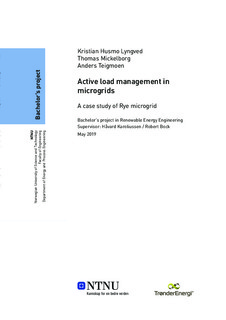| dc.description.abstract | Norway has a large coastal area with many islands that are provided with electricity from expensive sub-sea cables and long transmission lines. In stead of renewing existing infrastructure in remote areas, it could be cost efficient to implement local power production from renewable energy sources.
This thesis is a case study that considers one of four demos in Project REMOTE. The demo is located at Rye in the municipality of Trondheim, Norway. The project is partially EU funded and aims to demonstrate the technical and economic feasibility of fuel cell-based hydrogen energy storage systems in microgrids. The energy storage system (ESS) in the demo is a hybrid solution, consisting of a lithium-ion battery and hydrogen energy storage. The project is divided into two phases of operation. During the first, the system remains connected to the main grid, while during the second phase the goal is an off-grid system that requires less than 5 \% connection to the main grid, annually.
The main objective for this thesis is to investigate the possibility of downsizing the battery \mbox{capacity} of a planned 550 kWh battery at Rye microgrid. This is examined by implementing active load management (ALM) as a mean to utilize renewable power production more efficiently.
In order to achieve this objective, a four stage strategy was completed. The first stage consisted of creating a model of the microgrid. This included simulations of the solar energy production, loss calculations and a complete Simulink model. Secondly, a site survey of the microgrid, consisting of two farm sites, was performed to achieve knowledge of the flexibility potential. The third stage included developing an ALM algorithm in MATLAB. The algorithm performs energy conservation as the highest priority in order to decrease the load demand. Shifting flexible loads to hours with sufficient energy production is the second priority. The third priority is to shift remaining flexible loads to hours with the lowest consumption to increase the load factor of the system. The fourth and last stage consisted of analyzing the microgrid performance by investigating four different cases.
Each case has its own objective. Case 1 acts as a reference case where no ALM is performed. Case 2 applies a statistical method to define flexible loads, before ALM is performed. It is investigated if this method of classification can be regarded as valid. Case 3 is the most optimistic case, as it utilizes ALM on all the loads classified as flexible or power-shiftable. Case 4 is the most conservative case, as it only uses ALM on the most predictable of the flexible or power-shiftable loads. The flexibility potential, energy storage system performance and load factor is investigated for each case. This includes the amount of energy needed from the main grid, energy needed from hydrogen storage, throttled energy and battery lifetime expectancy. | |
